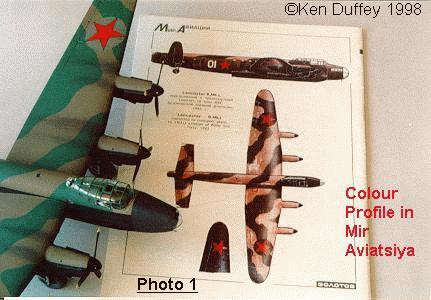
Because of my interest in Soviet aviation I subscribe to the Russian Aviation Research Group of Air-Britain. A recent bulletin of theirs featured a translation from a Russian aviation magazine of an article by Vladimir Kotel'nikov about Avro Lancasters operating under the Red Star. The translation, by Alex Boyd, was only text but quoted the source as being MIR AVIATSII for January 1992.

I was intrigued by this article as I was unaware that any Lancasters had been supplied to the Soviets and was determined to model one if possible. On a recent visit to Moscow I managed to obtain the relevant copy of Mir Aviatsii and this included a rather poor photograph of one of the Lancasters plus, on the back cover, a colour profile and plan view showing the necessary detail - so armed with this data I set about making the model.
According to the translated article, a combined Soviet and British force took part in 'Operation PARAVAN' in September 1944 against the German battleship Tirpitz which was sheltering in Alten fjord in Norway. Although damaged, Tirpitz still posed a threat to the convoys sailing between Great Britain and the Soviet Union.
From 0600 hrs on 12 September 1944 - 38 Lancasters, two Liberator transports and a single reconnaissance Mosquito were deployed to YAGODNIK aerodrome in the Archangel area. The Lancasters came from 617 and 9 squadrons and were a mix of Lancaster I's and III's specially adapted to carry 12,000lb 'Tallboy' bombs in a bulged bomb bay.
Ten of the Lancasters made forced landings at various airfields in the Archangel area, and following repairs to some of them, 27 Lancasters, with Russian navigators, carried out a bombing raid on the Tirpitz on 15 September 1944. The Tirpitz was damaged but remained afloat and was moved to Tromso fjord where she was attacked again, this time successfully, on 12 November from bases in the UK.
Between the 16th and 28th of September all the serviceable Lancasters returned to their bases in the UK. Six damaged Lancasters were left behind - one Mk III and five Mk I's, of which four were inspected by the Soviets with a view to restoration and the two with the least damage were taken to KEGOSTROV where they were repaired and modified in the workshops of the Air Force of the White Sea Flotilla under the direction of chief engineer KIR'YANOV.
All the armament was removed and the rear gun turret faired over with sheet Duralumin. The damaged nose section was replaced with a new transparent nose. The standard bomber finish of Dark Earth, Dark Green and Night was retained but the identification markings were overpainted in 'Russian green' and red stars with black outlines were applied in six positions, both machines being refurbished identically.
One of the Lancasters, with the side number '01' in white, was used by the 16th Transport Flight (the original article speculates that this may have been serialled ME559) for convoy escort, submarine detection flights and reconnaissance where its long range and endurance were much appreciated by the Soviets.
In August 1945 it was sent to the Pacific but became stranded at KRASNOYARSK due to lack of fuel. In the summer of 1946 it was flown to RIGA where it was used as an educational aid by the aviation technical college. Its subsequent fate remains unknown.
The second restored Lancaster, side number '02', served with the 70th Independent Transport Regiment of the Northern Fleet Air Force and eventually crashed whilst landing at IZMAILOVO outside Moscow at the end of the war and was written off.
There you have it - a fascinating article about the Soviet use of at least two Avro Lancasters that was completely unknown to me and to everyone else, if the reaction of those who saw the finished model on our Soviet Aircraft SIG stand at the IPMS UK Nationals is anything to go by. A number of people thought it should have been on the 'What if' SIG stand - hopefully this article will put them right.
Armed with sufficient data, I was ready to make the model. I chose to use the Airfix 1:72 scale kit of the Lancaster BIII as a basis for the conversion as it is the most accurate and is readily available. I did not know it at the time, but it would have been better to choose the ‘Dam Buster’ version as this has the mid-upper turret blanked off. Using the BIII kit meant that I had to blank off the turret aperture myself.
The main areas of conversion are to the fuselage - deletion of the mid-upper turret, provision of a new nose and a bulged bomb-bay and blanking off the rear turret. The cockpit was detailed first - I added a navigators table, a rear bulkhead, pilots armrest and trim wheel - just enough to make the cockpit area less spartan. I also cut away the mid-upper turret fairing and cemented scraps of plastic card in place to act as a ledge for more card and filler to be added later.
With the bomb-bay roof in place, the two fuselage halves were cemented together - minus the nose, mid-upper and tail turrets but including the side and upper window transparencies.
The kits' nose was sawn off just in front of the windscreen and a wooden plug, roughly cut to shape, was inserted into the resulting hole and cemented in place. The new nose has a very distinctive shape so, using the profile and plan views from Mir Aviatsii as a guide, I carefully carved and sanded the new nose to shape - see photo. Once satisfied that I had got the shape right, I removed the wooden nose and after polishing it, used it to plug-mould a new one from acetate, making two or three copies just in case.
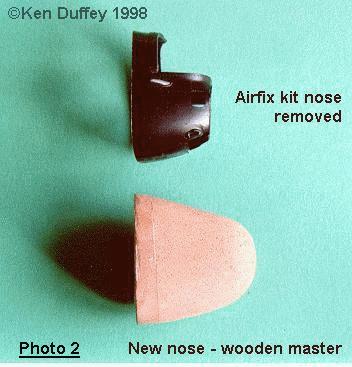
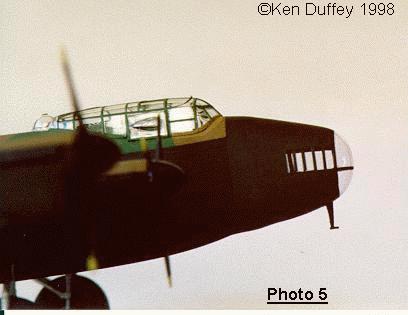
Turning back to the fuselage, I made a bulkhead from plastic card to fit the nose aperture and then added a second piece of thick plastic card to form a ledge around the nose so that the transparency fitted snugly. I added a floor, a seat and one or two 'boxes' to fill the nose area - all speculative, but enough to avoid having an empty nose area.
The interior of the new nose was painted black and when dry, the new transparency was cemented in place using tube cement - the ledge helping to form a strong enough joint. Do not use superglue for this otherwise you will get fogging on the inside of your nice new transparency!! The area between the new nose and the fuselage was blended in with filler to remove any traces of a join.
The Lancasters used on the Tirpitz raids were fitted with bulged bomb bays to accommodate the Tallboy bombs. This is not supplied by Airfix so a replacement will have to be obtained or made from wood. Mine came from the Matchbox Lancaster kit and is a perfect fit onto the Airfix fuselage.
As mentioned earlier, I had to remove the mid-upper turret fairing on my kit - use of the 'Dam Busters' version should avoid having to do this. My opening was filled with scrap plastic and blended in with filler. Rubbing the area down resulted in the loss of some rivet detail but as this is rather overdone on the kit, the rest of the model was lightly sanded down to match.
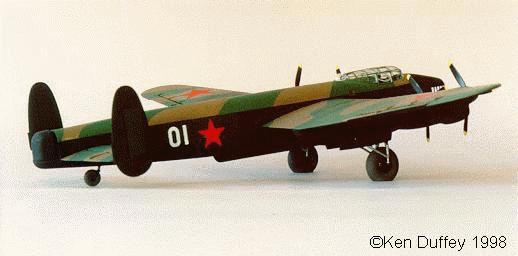
The tail turret was constructed from parts 10, 16 &17 - leaving out the interior detail and guns. When dry, the openings in the glazed section were filled with plastic card and blended in with filler. The locating lug was removed from the underside and the turret was cemented in place on the fuselage.
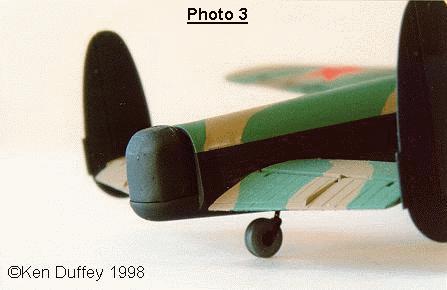
The rest of the kit was completed as per the instructions but I left off the propellers. The Tirpitz Lancasters had paddle-bladed props and these are available in the Aeroclub white-metal range - part number V031. They come complete with white-metal spinners, but I used the kit spinners which fitted the Aerclub blades perfectly.
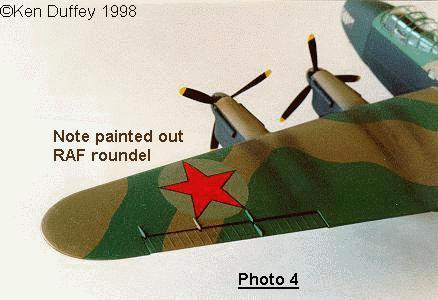
One final modification I made was to flatten the tires - nothing looks worse than a well made model standing on 'tip-toe'. I simply removed a slice from the bottom of each tire and added filler at the sidesto represent the bulges.
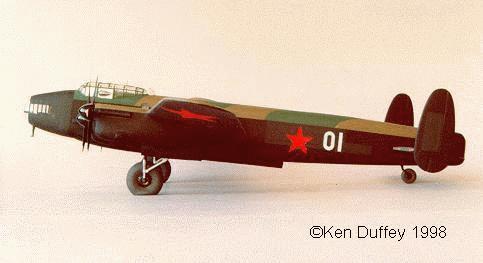
The Tirpitz raiders had standard RAF camouflage - I used Humbrol Dark Earth and Dark Green on the upper surfaces and, to save time, a spray can of Halfords Acryllic Gloss Black on the undersides. The whole model was then given a coat of gloss varnish ready for the application of the markings. I painted a section of clear decal film in Russian 'Topside Green' (Aeromaster 9073) and then cut out two circles the same diameter as the upper wing roundels on Airfix's decal sheet. These were placed in the normal roundel position to represent the areas where the original roundels were painted out by the Soviets. Matt black, with a little Olive Drab added to tone it down, was painted in the areas where the original RAF fuselage roundels and squadron codes would have been - a large rectangle on the fuselage sides with a smaller rectangle to cover the aircraft serial plus smaller rectangles on the outer fins where the fin flashes were.
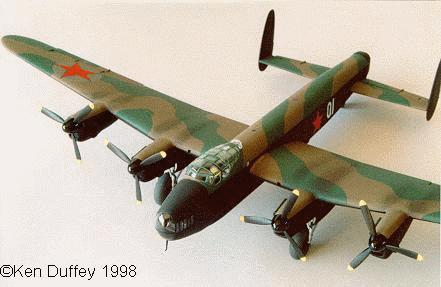
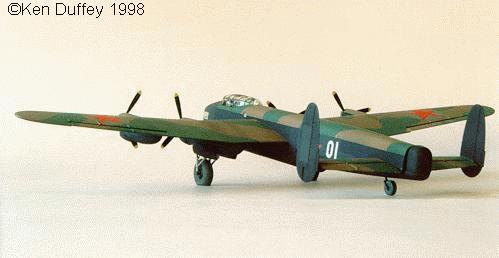
The aircraft's new nose and the tail turret were also painted in this off-black colour.
The black-outlined red stars for the fuselage and the white number '01' were obtained from the spares box, but the larger stars on the upper and lower wings posed a bit of a problem as I had nothing that matched.
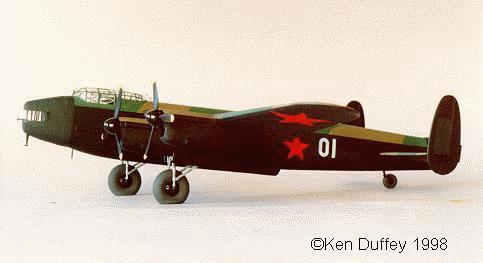
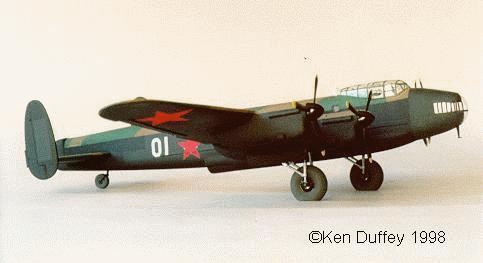
I solved it by cutting out a template of a five-pointed star from thin plastic card and, using a waterproof artists pen, drew four black outlines onto red decal sheet. These were then cut out and placed in position on the wings - the two upper stars over the previously applied 'Russian Green' patches and the underside stars directly to the wing.
The model was finally given an overall coat of matt varnish to seal in the decals.
The only other detail apparent on the side profile is a pitot fitted under the new nose - I used kit part 125, with its mating surface sanded down to match the new nose contours, cemented in place centrally under the nose.
I enjoyed this conversion - it is fairly simple but results in a distinctly different version of the Lancaster and one that causes a few raised eyebrows wherever I display it. I wonder what other secrets are still to come out of Russia - indeed I wonder if the remains of ME559 are still around somewhere!!
Ken Duffey
June 1998
References